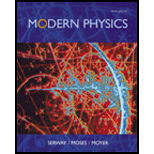
Concept explainers
(a)
The frequency of revolution and the orbit radius of the electron in the
(a)
Answer to Problem 36P
The frequency of revolution in the Bohr model of hydrogen for
Explanation of Solution
Write the expression for the frequency of the revolution of the electron in the Bohr model of the hydrogen atom.
Here,
Write the expression for the
Here,
Write the expression for
Here,
Use equation (III) and (II) in (I) to solve for
Conclusion:
Substitute
Substitute
Substitute
Substitute
Substitute
Substitute
Therefore, the frequency of revolution in the Bohr model of hydrogen for
(b)
The photon frequency for transitions from the level
(b)
Answer to Problem 36P
The photon frequency for transitions from the level
Explanation of Solution
Write the expression for the photon frequency for transitions from the
Here,
Write the expression for the
Here,
Use equation (VI) in (V) to solve for
Write the expression for the difference in frequency.
Conclusion:
Substitute
Substitute
Substitute
Substitute
Substitute
Substitute
Therefore, the photon frequency for transitions from the level
(c)
Verify the correspondence principle in the transitions.
(c)
Answer to Problem 36P
Verified that
Explanation of Solution
The correspondence principle states that “predictions of quantum theory must correspond to the predictions of classical physics in the region of sizes where classical theory is known to hold”.
If the quantum number becomes large because of increased size or mass, we may state the correspondence principle symbolically as
As the quantum physics tends to classical physics in the limit of large quantum numbers implies the
The value of equation (IV) and (VI) tends to almost equal to same value as the value of
Conclusion:
Therefore, it is verified that
Want to see more full solutions like this?
Chapter 4 Solutions
Modern Physics
- Consider the electron of a Li2+ ion that undergoes a transition from a higher energy state n to its adjacent lower energy state n – 1 (e.g. n = 2→1, 3→2, 4→3, etc) and emits a photon. Suppose the emitted photon is used to strike the surface of potassium, which has a threshold frequency of 5.464 × 10^14 s–1.a) Whatisthemaximuminitialquantumnumber,n, that is required in order to emit a photon with high enough energy to generate a photocurrent from the metal surface?b) Usingthenvaluesolvedinpart(a), calculate the maximum speed of the photoelectron from potassium. If you couldn’t solve for n in part (a), use n = 3.arrow_forwardConsider a hydrogen atom in a large magnetic field. Compute the wavelengths of the photons when it transitioned from the 2p → 1s levels when the hydrogen atom is placed in a magnetic field of 2.00 Tesla. In total, consider the three transitions L=1 (2p) to L=0 (1s) associated with the three states ?ℓ= −1, 0, +1. Draw the energy levels for B=0 T and B=2 T. Ignore the effects of the intrinsic electron’s spin angular momentum and only consider the effect of the orbital angular moment L on the energy levels.arrow_forwardCalculate the frequency of the photon absorbed when the electron in a hydrogen atom transitions from the ground state to the state with n = 7. Express your answer as f x1015 Hz and type in only the value of f.arrow_forward
- If the radius of the lowest energy orbit (n = 1) is 0.529 × 10-10 m, calculate the radii in m of the Bohr orbits defined by principal quantum numbers 4 and 5. (Hint use equation 1.5 and work out the overall value of the collected constants from the value of r at n = 1).arrow_forwardFor the hydrogen atom in its ground state, calculate (a) the probability density c2(r) and (b) the radial probability density P(r) for r = a, where a is the Bohr radius.arrow_forwardThe longest wavelength line of the Balmer Series for hydrogen occurs at 656.3 nm corresponding to the transition from n2 = 3 to n1 = 2. Determine the value for the Rydberg constant for hydrogen using these values.arrow_forward
- For a hydrogen atom in an excited state with principal quantum number n, show that the smallest angle that the orbital angular momentum vector can make with respect to the z-axis is =cos1( n1n) .arrow_forwardDerive an expression for the ratio of X-ray photon frequency for two elements with atomic numbers Z1 and Z2.arrow_forwardConsider hydrogen in the ground state, 100 . (a) Use the derivative to determine the radial position for which the probability density, P(r), is a maximum. (b) Use the integral concept to determine the average radial position. (This is called the expectation value of the electrons radial position.) Express your answers into terms of the Bohr radius, a0. Hint: The expectation value is the just average value, (c) Why are these values different?arrow_forward
 Modern PhysicsPhysicsISBN:9781111794378Author:Raymond A. Serway, Clement J. Moses, Curt A. MoyerPublisher:Cengage Learning
Modern PhysicsPhysicsISBN:9781111794378Author:Raymond A. Serway, Clement J. Moses, Curt A. MoyerPublisher:Cengage Learning Physics for Scientists and Engineers with Modern ...PhysicsISBN:9781337553292Author:Raymond A. Serway, John W. JewettPublisher:Cengage Learning
Physics for Scientists and Engineers with Modern ...PhysicsISBN:9781337553292Author:Raymond A. Serway, John W. JewettPublisher:Cengage Learning Principles of Physics: A Calculus-Based TextPhysicsISBN:9781133104261Author:Raymond A. Serway, John W. JewettPublisher:Cengage Learning
Principles of Physics: A Calculus-Based TextPhysicsISBN:9781133104261Author:Raymond A. Serway, John W. JewettPublisher:Cengage Learning University Physics Volume 3PhysicsISBN:9781938168185Author:William Moebs, Jeff SannyPublisher:OpenStax
University Physics Volume 3PhysicsISBN:9781938168185Author:William Moebs, Jeff SannyPublisher:OpenStax



